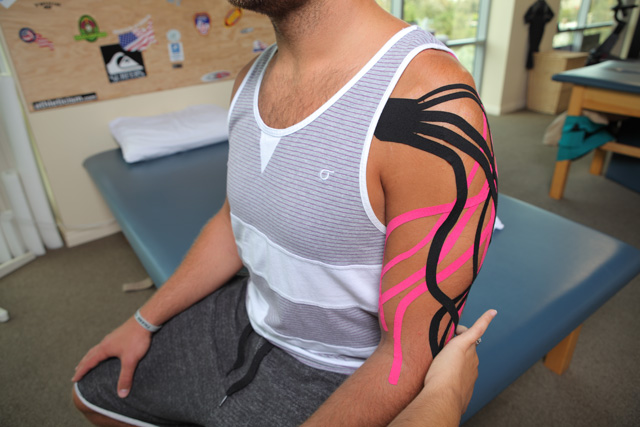You’ve seen it everywhere—from pro athletes to casual weekend runners. Bright strips of tape stretched over shoulders, knees, and backs, or tightly wrapped ankles before a big game. But if you’ve ever wondered, “What is athletic tape actually made of?”—you’re asking the right question.
Because when it comes to your body, materials matter. Especially when you’re using something that sticks to your skin, compresses your muscles, and affects your movement.
At Revolution Rehab, we don’t just use tape—we use it strategically, based on how it interacts with your skin, your tissue, and your mechanics. And knowing what it’s made of helps you choose the right kind (or avoid the wrong one).
Why Athletic Tape Materials Actually Matter
Here’s the thing: not all athletic tapes are created equal. The materials they’re made from affect:
- How long they last
- How well they stick to skin
- How much support or stretch they offer
- How breathable they are
- Whether they’ll irritate your skin or trigger allergies
If you’ve ever had a rash after using tape, had it peel off mid-workout, or felt like it restricted you too much, chances are the issue wasn’t your technique—it was the tape’s material.
Let’s unpack the most common types and what they’re made of.
Common Athletic Tape Materials (By Type)
1. Kinesiology Tape
What it’s made of: Most kinesiology tape is made from a cotton and elastic fiber blend, usually spandex or a synthetic alternative like polyester. It also features an acrylic-based adhesive that’s activated by body heat.
Why it matters:
- Cotton is breathable and lightweight, which helps with comfort and moisture control.
- Elastic fibers allow the tape to stretch up to 140-180% of its original length, mimicking skin and muscle movement.
- The acrylic adhesive is hypoallergenic and latex-free—perfect for people with sensitive skin.
Pro insight: Good kinesiology tape should be water-resistant, not peel easily with sweat, and last several days even with movement. Brands like RockTape or KT Tape use high-grade materials for this.
2. Rigid Athletic Tape (Zinc Oxide Tape)
What it’s made of: Rigid tape is usually composed of 100% cotton or rayon fabric with a zinc oxide-infused adhesive.
Why it matters:
- The cotton or rayon base gives it a strong but non-stretchable structure—ideal for immobilizing joints.
- Zinc oxide adhesive sticks like glue and resists moisture, making it great for high-sweat sports.
- Some versions contain latex, so always check the label if you have a known allergy.
Pro insight: This stuff is built to stay on through an entire game. But it can also irritate skin if used without a barrier or underwrap, especially for long durations.
3. Elastic Adhesive Bandage (EAB)
What it’s made of: Typically made from a cotton-elastane blend, with a rubber-based or synthetic adhesive.
Why it matters:
- The elasticity offers a middle ground between rigid tape and kinesiology tape—it supports but doesn’t fully lock down a joint.
- Rubber adhesives provide tackiness, but they’re not great for sensitive skin.
- Some newer versions use latex-free adhesives for improved skin tolerance.
Pro insight: EAB is best for larger muscle areas and compression-style wraps. But if you sweat a lot, make sure you pick a brand with strong adhesion.
4. Cohesive Tape (Self-Adherent Wraps)
What it’s made of: Usually constructed from non-woven synthetic fibers with a cohesive (non-adhesive) surface. It sticks only to itself.
Why it matters:
- No skin contact means zero allergic reaction risk.
- The material is lightweight, breathable, and stretchy, making it perfect for temporary wraps or holding bandages in place.
- Latex versions exist, so read the label if you’re allergic.
Pro insight: Great for short-term use or sensitive areas. Not ideal for serious joint support since it doesn’t grip skin.
5. Leukotape & Cover-Roll
What it’s made of:
- Cover-Roll: A polyester fabric with a skin-friendly acrylic adhesive
- Leukotape: A rayon backing with an ultra-strong zinc oxide adhesive
Why it matters:
- The polyester layer is soft and gentle, great for sensitive skin or areas prone to blistering
- The Leukotape on top delivers firm, directional support
- It’s a go-to for McConnell taping techniques, which help with patellar or shoulder tracking
Pro insight: This two-part system is widely used in rehab settings, including at Revolution Rehab, for posture correction and chronic joint issues.
The Adhesive Factor: What’s Sticking to Your Skin?
Let’s talk glue—because the adhesive is just as important as the tape’s fabric.
Common Adhesives in Athletic Tape:
- Acrylic-based adhesives:
Hypoallergenic, latex-free, and activated by heat. Found in most kinesiology tapes and medical-grade options. Skin-safe and breathable. - Zinc oxide adhesive:
Very sticky and water-resistant. Long-lasting, but can be harsh on sensitive skin. Often used in rigid tape. - Rubber-based adhesives:
High-tack, elastic-friendly, but can cause reactions in people with latex sensitivities.
Skin tip: Always test a small piece of tape first if you’ve never used it before—especially if you’ve had skin issues in the past.
Is Athletic Tape Eco-Friendly?
If you care about sustainability, here’s the short version: most athletic tapes are not eco-friendly. They’re synthetic, single-use, and adhesive-heavy.
However, some companies are exploring biodegradable options or recycled packaging. And kinesiology tape made with organic cotton is starting to pop up—but it’s still rare and often less durable.
At Revolution Rehab, we keep eco-conscious tape options in stock when available, and we always dispose of medical waste responsibly.
Common Skin Reactions to Tape (And How to Avoid Them)
Reactions can happen—even with hypoallergenic tape. Here’s what to watch for:
- Redness or itching after removal
- Blisters or peeling skin
- Painful rashes or discoloration
Tips to avoid reactions:
- Choose latex-free, acrylic-based adhesives
- Use a barrier spray before taping sensitive skin
- Never tape over broken or freshly shaved skin
- Don’t leave tape on longer than needed
If irritation happens, stop using the tape immediately and let your skin breathe. We can help recommend a better option based on your skin type.
Athletic Tape in Practice: How We Use It at Revolution Rehab
At Revolution Rehab, we don’t just tape and hope for the best. We:
- Analyze your movement patterns
- Identify mechanical stress or injury risk
- Choose the right tape material based on your skin, injury, and sport
- Teach you how to apply it yourself—properly
We also test for any skin sensitivity before committing to long-term taping strategies.
And more importantly—we make sure tape is just one part of your recovery or prevention plan.
When You Should Book a Consult Instead of DIY-ing It
If you’re dealing with:
- Ongoing joint pain
- Muscle strains that keep coming back
- Skin reactions from tape
- Confusion over which tape to use
It’s time to book a professional assessment. We’ll walk you through which tape works for your body, how to apply it, and what else your recovery plan needs.
Final Thoughts: What’s Sticking to Your Skin Shouldn’t Be a Mystery
Now you know—athletic tape isn’t just colorful decoration or a quick fix. What it’s made of directly affects how it works, how long it lasts, and how your body responds to it.
Whether it’s cotton, synthetic, zinc oxide, or acrylic—each material has a purpose. And when used right, tape can support your performance, prevent injury, and speed up your recovery.
But if you’re not sure where to start, let us help.
Book With Revolution Rehab — The Tape Experts Who Know the Science
From elite athletes to everyday movers, we’ve helped hundreds learn how to tape smarter, not just tighter. We take the guesswork out of recovery and bring clarity to what your body needs.
Book a consultation at Revolution Rehab today, and let’s figure out what tape works best for you—based on real movement analysis and expert-level care.


